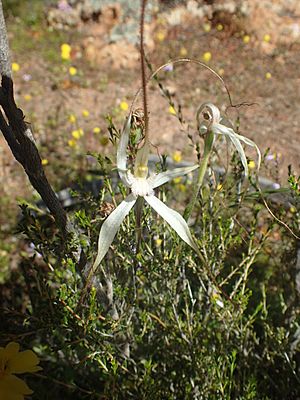Perenjori spider orchid facts for kids
Quick facts for kids Perenjori spider orchid |
|
|---|---|
 |
|
| Caladania remota subsp. parva growing near the Perenjori-Rothsay track | |
| Scientific classification |
|
| Kingdom: | Plantae |
| Clade: | Tracheophytes |
| Clade: | Angiosperms |
| Clade: | Monocots |
| Order: | Asparagales |
| Family: | Orchidaceae |
| Subfamily: | Orchidoideae |
| Tribe: | Diurideae |
| Genus: | Caladenia |
| Species: |
C. remota
|
| Subspecies: |
C. r. subsp. parva
|
| Trinomial name | |
| Caladenia remota subsp. parva Hopper & A.P.Br.
|
|
| Synonyms | |
|
|
The Perenjori spider orchid (scientific name: Caladenia remota subsp. parva) is a special type of plant. It belongs to the amazing orchid family, known for its beautiful and unique flowers. This particular orchid is found only in the south-west part of Western Australia. When a plant or animal is found only in one specific area, it is called endemic.
This orchid has a single leaf that feels a bit hairy. Its flowers are a lovely creamy-white or pale yellow color. You might see up to three flowers on one plant. The Perenjori spider orchid grows in a smaller area compared to its close relative, subspecies remota.
Contents
What Does This Orchid Look Like?
The Perenjori spider orchid is a ground-dwelling plant. This means it grows in the soil, not on other plants or trees. It is also a perennial plant, which means it lives for more than two years. Every year, its leaves fall off, but it grows back from an underground tuber (like a small potato).
Leaves and Stems
Each orchid has one leaf that stands straight up. This leaf is about 15 to 17 centimeters (6 to 7 inches) long. It is also about 0.5 to 0.7 centimeters (0.2 to 0.3 inches) wide. The leaf has tiny hairs on it. The flowers grow on a stem that is about 14 to 20 centimeters (5.5 to 8 inches) tall.
Amazing Flowers
The flowers of the Perenjori spider orchid are quite striking. They can be cream-colored or creamy-yellow. Each flower is about 5 to 8 centimeters (2 to 3 inches) long and 4 to 6 centimeters (1.5 to 2.5 inches) wide.
Flower Parts Explained
The flower has parts called sepals and petals. These parts have long, thin, brown tips that look like threads.
- The top sepal stands straight up.
- The two side sepals spread out and point downwards.
- The petals spread out sideways at first, then they also turn downwards.
The most interesting part is the labellum, which is like the orchid's "lip." It is about 0.9 to 1.4 centimeters (0.35 to 0.55 inches) long and 0.8 to 1 centimeter (0.3 to 0.4 inches) wide. The labellum is cream-colored with red lines and marks. Its sides have many short, blunt teeth. The tip of the labellum curls under. In the middle, there are two rows of special bumps called calli. These calli are shaped like tiny anvils and are white, sometimes with red tips.
When Does It Bloom?
You can see the Perenjori spider orchid in bloom from August to the middle of September.
How This Orchid Got Its Name
Scientists give every living thing a special scientific name. This helps everyone around the world know exactly which plant or animal they are talking about.
Caladenia remota was first officially described in 2001. Two scientists, Stephen Hopper and Andrew Phillip Brown, did this work. They published their findings in a science journal called Nuytsia. At the same time, they also described two different types, or "subspecies," of this orchid. One of these was subspecies parva.
The word parva comes from Latin, and it means "little." This name was chosen because this subspecies is smaller than the other one, subspecies remota.
Where Does This Orchid Live?
The Perenjori spider orchid grows in Western Australia. You can find it in the area between the towns of Perenjori and Wubin.
It usually lives in areas called shrublands. These are places with many shrubs and small bushes. The ground in these shrublands gets very wet during the winter months, which the orchid needs to grow.
Is This Orchid Safe?
Good news! The Perenjori spider orchid is currently not considered to be in danger. The Western Australian Government's Department of Parks and Wildlife has classified it as "not threatened." This means it is not at risk of disappearing.
Images for kids


